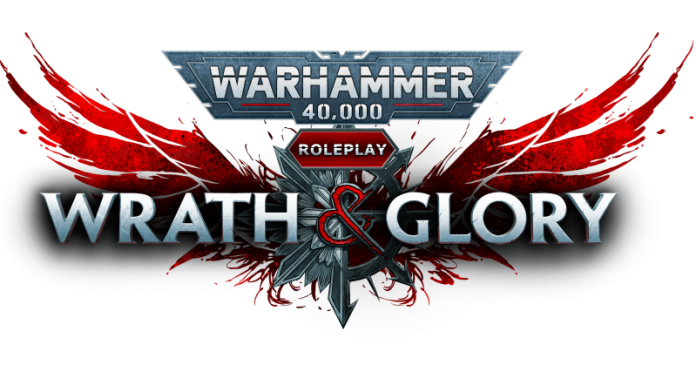Grim darkness. Far future. Only war. No peace. Warhammer!
Chances are pretty good that if you’re on this particular site reading this particular article you probably don’t need an introduction to Warhammer 40k, but you might not be familiar with Warhammer 40,000: Wrath & Glory, the tabletop role-playing game published by Cubicle 7. Much like its cousin Warhammer Age of Sigmar: Soulbound, Wrath & Glory is a fully contained game, requiring nothing beyond the core book to run a perfectly cromulent campaign.
In the interest of transparency, I want to mention up front that this review is neither paid nor sponsored; Cubicle 7 has not provided me with any material or content for review purposes. I did however run a campaign for about two years so when the demand came for a Goonhammer review I leapt at the chance.
A Complex History
Originally put out by Ulisses Spiele in 2018, Wrath & Glory sputtered out not long after launch, putting out only the core book and one adventure pack. In a surprise move, Cubicle 7 picked up the license in 2019 and by early 2020 a new edition of the game hit (digital) shelves. This new edition was still based on the same core mechanics and ideas but was recognizably its own different game. The C7 version streamlined the game, cutting some of the more unusual gameplay aspects such as the Campaign Card deck that allowed players to drastically alter play or the Threatening Tasks minigame that represented intense and time-sensitive situations requiring multiple resolutions (think Skill Challenges from 4e D&D).
Unlike the earlier Fantasy Flight Games lines of 40k RPGs, Wrath & Glory doesn’t focus on one facet of the galaxy to explore in depth. Instead it aims for a broader experience, where your options are (to a degree) more open. You’re not limited to the sort of characters that you might find on a Rogue Trader vessel or serving in an Astra Militarum Regiment; your party could easily consist of a veteran Guardsman, a Techpriest, a Sister of Battle, and a Tactical Marine. In fact, depending on your campaign you might even have an Aeldari Warlock join the fray.
That’s not to say that it’s a wild free-for-all every time. Each campaign of Wrath & Glory starts with a Framework laid out by the Game Master which describes the overall concept of the campaign and the types of missions the party will encounter. The Frameworks are very specific to certain patrons and their goals; a sample Framework might be “an Archdeacon in the Ecclesiarchy employs you to punish blasphemy and enforce Ecclesiarchal law.” Each Framework comes with an associated set of mechanical benefits and equipment and also a set of limitations. These limitations narrow the scope of what can be played in the Framework by either requiring or prohibiting certain keywords and/or Ranks and Tiers of power (more on those in a moment). To use the earlier example of the Archdeacon, the party could receive a cherub servitor or symbols of Ecclesiarchal authority as well as a bonus to certain social rolls against characters with the Imperium keyword, but would all have to have the Imperium keyword themselves and likely not the Scum keyword.
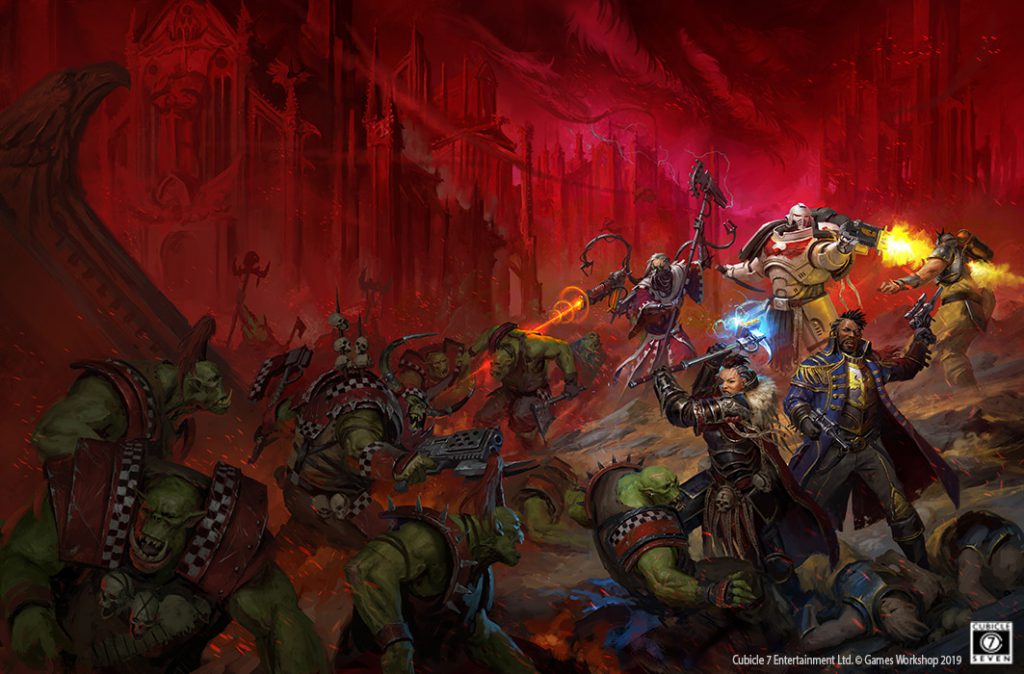
Each campaign is also set at a certain Tier, which provides an estimate of the general power level of the characters but also factors into the types of enemies that might be encountered. A Tier 1 party of hive gangers will find a daemon-possessed mortal to be a pretty tough challenge, while a Tier 3 party of Marines could easily dispatch one without breaking a sweat. Character Archetypes (what other games might call classes) are tied to specific Tiers but can always Ascend to higher Tiers either at character creation or (more rarely) in the course of play by selecting an Ascension Package which grants a handful of mechanical bonuses as well as a fun narrative change. A Guardsman ascending to Tier 3 could have been conscripted into the Inquisition’s service, or betrayed the Guard to join a Chaos cult, or even had their psychic awakening. Each Tier also has three Ranks within it, which are less significant but serve to affect bonuses granted by other factors.
A Motley Crew
At this point you might well ask what kind of a campaign has a Techpriest, a Tactical Marine, a super Guardsman, and a Warlock hanging out together? From my experience the answer is a very tense one, but the real answer lies in the literal gap between 7th and 8th Edition of 40k. The default setting of Wrath & Glory is the Gilead System, a once prosperous collection of worlds imperiled by the appearance of the Great Rift. For the few who might not be familiar with the concept, the TL;DR is that due to Circumstances the galaxy now has a big crack down the middle that leads to Space Hell. The Imperium is now divided into a relatively okay half (Imperium Sanctus) on the side closer to Terra and a pretty boned side (Imperium Nihilus) which can’t see the navigational beacon of the Astronomican any more thanks to said crack in space. This leads to some pretty desperate times in the Imperium Nihilus as sectors and even systems (such as Gilead) are now cut off from each other and strange alliances start to form for mere survival since they’re easy pickings for all the truly nasty stuff.
Building a character in Wrath & Glory is a somewhat complicated affair. Without going into minute detail, you’re given an amount of experience points based on your campaign’s Tier to spend on your Species (Human, Astartes, Primaris, Ork, or Aeldari), Attributes, Skills,Talents, and (if applicable) Psychic Powers. Currently the game supports eight species including those found in supplements, but the options for any non-Human are pretty limited. In the core book alone there are thirteen Archetypes which can be taken by humans while the Aeldari and Orks only have three Archetypes each, a situation which is only compounded on with the Player’s Guide.
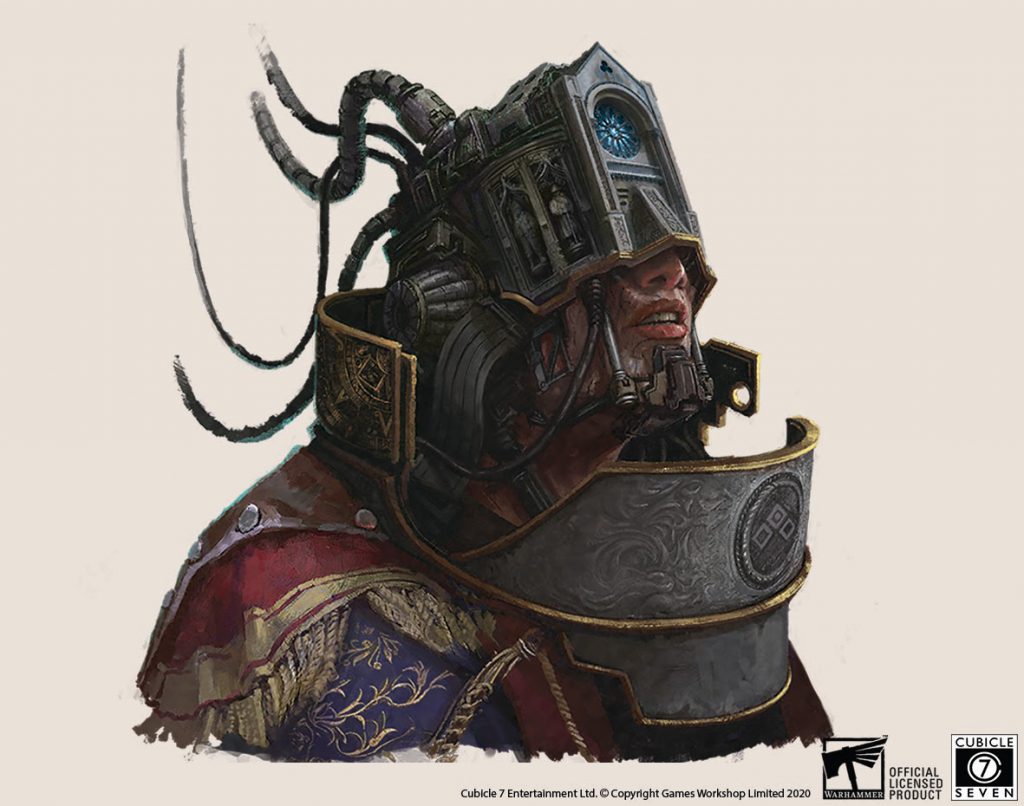
This is honestly a bit of a problem with Wrath & Glory as a whole; for a game line that tries to be everything to everyone it feels a lot more like Henry Ford’s statement that “any customer can have a car painted any colour that he wants so long as it is black.” Not only are the majority of the Archetypes meant for humans, the printed adventure modules also overwhelmingly assume a human party, usually Imperial as well. I understand that humans are very much the “default” point of view for a lot of the fiction of the setting so far and we have a great amount of detail about human institutions, but the lack of Xenos support (aside from some vehicle rules in the latest supplement) is a little disheartening especially since the roadmap under Ulisses Spiel outlined a massive Aeldari sourcebook as one of its first planned publications.
After Species and Archetypes, characters are primarily mechanically composed of Attributes, Skills, and Talents. Attributes and Skills will be familiar to anyone who’s touched an RPG before: Attributes govern raw ability while Skills represent specific learned application. These are all pretty standard, though the inclusion of Initiative in the Attributes section may raise an eyebrow or two. Many RPGs lump fine motor skills and quickness together in a single score like Dexterity in D&D, while Wrath & Glory breaks them apart into two Attributes, Agility and Initiative. Initiative indicates reaction speed and at first glance might seem less important as it’s only used with one Skill (Weapon Skill), but it also determines a character’s Defence score so it becomes incredibly important.
Talents are aspects of a character that grant either some sort of bonus on particular types of tests or some sort of ability not represented by dice pools. Each Talent has an XP cost and may have a specific set of requirements such as a minimum Rank, Species, or keyword. Broadly, these are great for distinguishing your character from similar characters. However, this is also where the game balance can fly out the window. For example, for 30 XP a Guardsman can buy a Talent that has a chance to mitigate the cost of trying to soak damage, or for a few XP less that same Guardsman can replace their lasgun with a plasma gun or a melta gun either of which will trivialize combat at anything up to Tier 4. Both of these Talents are combat-oriented and are around the same cost, but one of them is clearly a better option than the other, and there are a handful of other similar cases.
The finishing touches of a character are built out on a faction-specific level, including character Backgrounds and subfaction details. Backgrounds consist of three portions representing your origin, a notable accomplishment in your past, and your future goals. The Backgrounds are somewhat vague, consisting of ideas like “your entire squad was destroyed except for you” rather than specifics like “you fought in the invasion of the Stygius Sector,” so you generally won’t need to reflavor them. Each Background has an associated minor bonus such as increased Wounds or Wealth, but you only gain the benefit of one of the three.
The subfaction detail options vary pretty wildly based on your subfaction. Some choices have no mechanical impact, some provide only a keyword, and some provide both benefits and drawbacks. For example, Scum gain absolutely nothing while Aeldari get their Craftworld or Coterie keyword as well as a Path and the option to buy more Paths if playing as a Craftworlder. This is also where the rules for building a Chaos character come into play; sadly they’re a little lackluster, consisting mostly of swapping out Imperial keywords for their Chaos equivalents, adding another keyword to represent a Mark of Chaos, and maybe tweaking an ability. Notably, Heretic Astartes have no Legion traits to replace the Chapter traits gained by their loyalist counterparts. Chaos characters get a little more love in the Talents section with options to get things like daemon familiars or the actual benefit of a Mark of Chaos, but overall the game’s approach really does seem to be to scratch out “Imperium” and write “Chaos” in Sharpie.
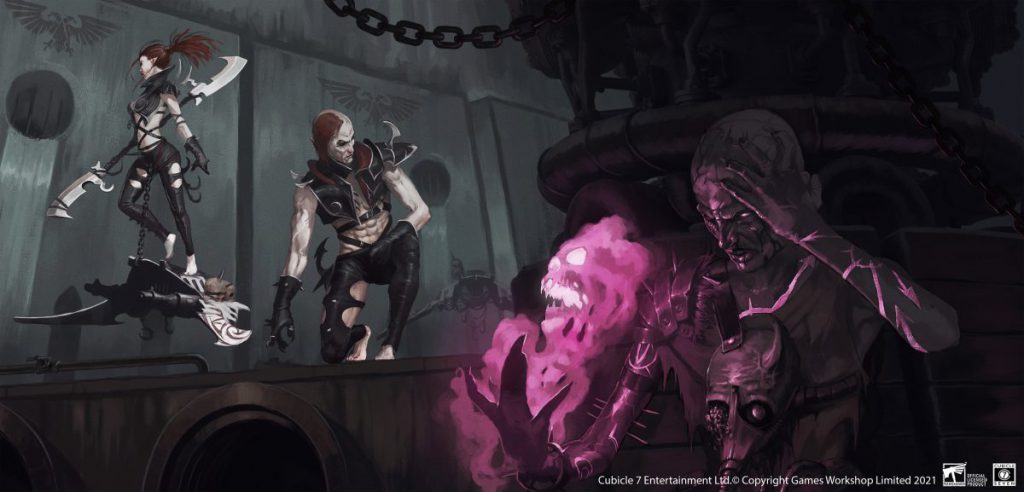
Roll Them Bones
The core system for Wrath & Glory is reasonably straightforward: you roll a dice pool based on a Skill and its linked Attribute, counting any results of 4+ as successes (aka Icons) with 6s (Exalted Icons) counting for double. You then compare the number of successes against a Target Number set for the difficulty of the test by the GM, and any successes above and beyond the TN can be used to perform the task better/faster/harder/stronger. The wrinkle in this system is the Wrath Die, a mechanic that will be familiar to anyone who’s played West End Games before. One die in your pool is a different color from the rest and if that die comes up a 1 (a Complication) something terrible happens in the process. Maybe you convince the Administratum clerk to help you but you know you’ll get reported; maybe you shoot the stupid ‘umie but step in a grot and fall on your face. Conversely, rolling a 6 on the Wrath Die either activates a Critical Hit in combat, or adds a point of Glory to the table pool.
Speaking of resource pools, Wrath & Glory uses three of them, and you’ll never guess what two of them are named. Wrath is a personal pool for each PC which refreshes at the start of each session and allows you to reroll failed dice as well as make minor narrative declarations and recover Shock (the game’s nonlethal damage track). Glory is a shared pool which allows the PCs to add dice or damage, pump Critical Hits for nastier effects, and swerve the initiative track a little. Finally, Ruin is the GM’s pool used for most of the same things as both Wrath and Glory points, as well as activating certain types of NPC actions and reactions. Some NPCs will have their own personal Ruin pools as well and those are generally your “boss” level NPCs, capable of eating any given PC’s lunch.
As systems are wont to do, it becomes more complicated from there. The system for combat is fairly involved which… okay, let’s face it, we all expected that. One of its most notable changes to the “standard” of RPG design is that initiative isn’t rolled but rather goes in back-and-forth order between PC and NPC slots, with anyone from either side free to use the slot if they haven’t already done so that round. Attacks themselves are fairly straightforward, with any surplus Exalted Icons on a successful attack shifting to provide Extra Dice on the damage roll, the Icons of which are then added to the raw damage of a weapon to determine the final result. Defense turns into a bit of a gamble as the final damage gets compared to the defender’s Resilience score (a sum of armor and natural toughness), then they roll to try to essentially convert some of the incoming damage from Wounds (lethal damage) into Shock (again, nonlethal damage). Because Wrath & Glory tries to convert just about everything from the wargame, Mortal Wounds also come into play from some sources such as fire or psychic powers, bypassing most attempts to mitigate that damage.
In addition to the standard melee and ranged attacks and a host of variant actions granting some forms of bonuses or penalties, Wrath & Glory takes the time to codify some not-necessarily-violent ways to participate in combat with Interaction Attacks which are ways to use some types of Skill tests to impair opponents. Combat also utilizes a sizable number of Conditions which can represent anything from being set ablaze to being pinned down by suppressing fire, and of course there are tables for Critical Hits as well as horrific Battle Scars and Memorable Injuries.
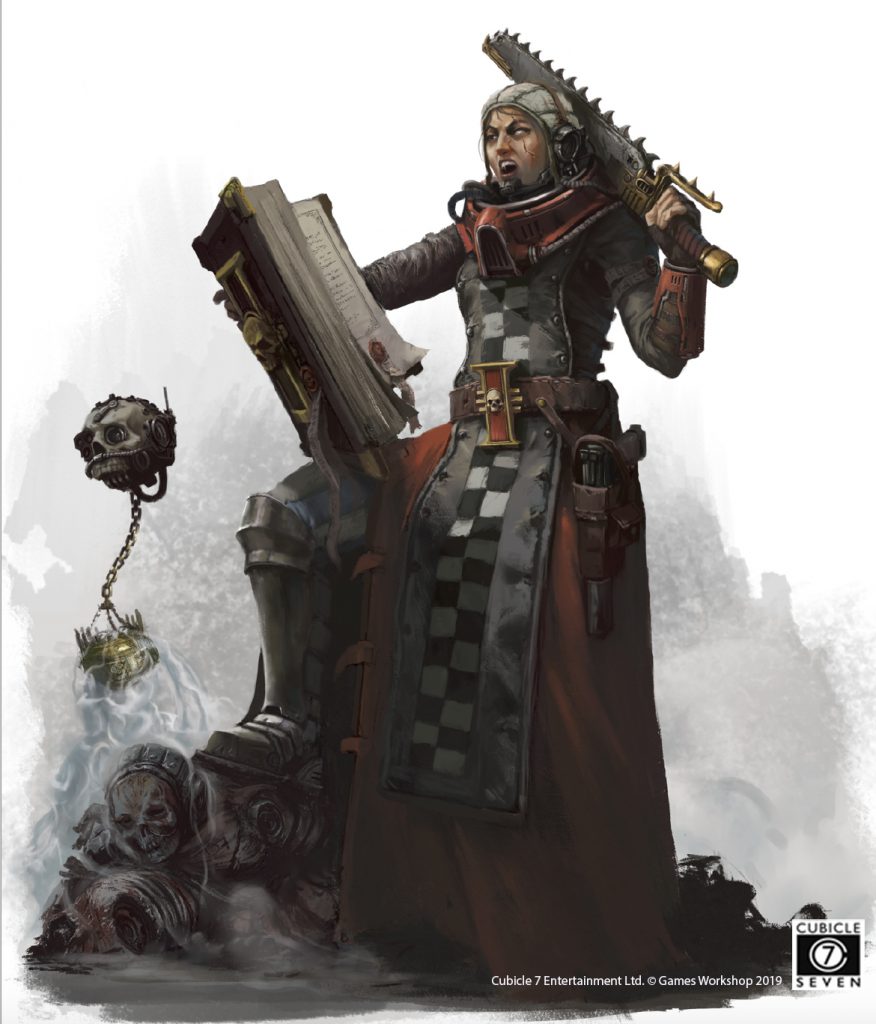
Surprising absolutely no one, Wrath & Glory has a boatload of equipment in the Wargear section. Equipment isn’t purchased so much as obtained since you can’t exactly go down to the local bolter store, and there’s a subsystem here for throwing your weight around for exactly that purpose. The weapons of Wrath & Glory map to the wargame weapons fairly neatly, and in fact you can do some quick calculations to directly convert wargame weapon stats to Wrath & Glory. Since raw numbers can only do so much, each weapon (and some of the armors) comes with a set of Traits that define the weapon. The differentiation between, say, a chainsword and a regular sword lies mostly within the chainsword’s Brutal trait which grants a +1 to the die results of its ED – meaning that its core damage trait isn’t much higher but it can achieve some truly nasty damage on a lucky hit.
From there we get a fairly similar armor section, though it does some strange things in breaking apart different aspects of what the tabletop considers an invulnerable save into the twin aspects of ignoring AP and being able to roll Determination against Mortal Wounds. Tools and Equipment are all of the little things that aren’t necessarily very sexy but either provide necessary function (vox links, void suits) or minor benefits (combi-tools, survival kits). Augmetics are also covered in this section and are reasonably difficult to obtain, which makes sense given that some of these are straight-up improvements to Attributes. Finally, Wargear rounds itself out with the Trinkets section, which is a fine but forgettable set of tables for a random item received during character creation which doesn’t have any real effect.
Mind Bullets
Psychic powers also get their own subsystem accessible only to those with the Psyker keyword which either comes from an Archetype, an Ascension Package, or just from existing as an Aeldari. Most powers fall within a Psychic Discipline along a theme such as Pyromancy or Telepathy, with Chaos getting their own Discipline full of some truly nasty effects and the Aeldari getting a neat setup with Runes of Battle where ever power has two diametrically opposed options such as Conceal/Reveal. The number of powers available to a character as well as the number of available Disciplines varies depending on the Archetype, Talents, and Species chosen. Much like Talents, some of these absolutely aren’t balanced against each other – the main suspect here is Molten Beam, a Pyromancy power that deals significantly more damage than any other power (think meltagun) and is much easier to activate as well. Chaos has a definite contender with Possession which allows the user to dictate the actions of another character without any restrictions whatsoever; this is wildly abusable and could easily result in the death of a PC or even the whole party.
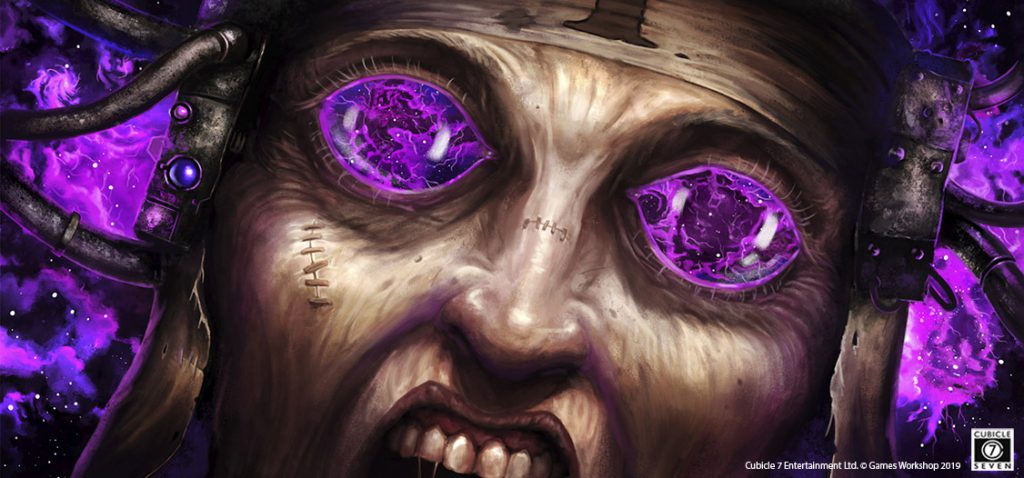
Acting as a conduit to Space Hell for fun and profit isn’t the safest idea that anyone’s ever had, and so psychic powers have their own little gambling minigame. When using a psychic power you can choose to add zero, one, or many dice to your pool with the caveats that they all have to be Wrath Dice and you can’t back down to a lesser level of casting during an encounter. If any of those Wrath Dice roll a Complication, you get to take an all-expenses paid trip to the Perils of the Warp. To be honest these aren’t necessarily so bad mechanically; you roll on a d66 chart to determine the result (adding +10 for every additional 1 that you rolled on the Wrath Dice, so enjoy that gamble) and your results could be anything from “horror movie light flickers” to inflicting Conditions on everyone around you. The truly horrible results require you to either roll multiple Complications or experience other extenuating circumstances, and can include results like “a daemon lives inside your mind now, have fun with that” or “one of the Chaos Gods looks at you, enjoy some Corruption.”
Aeldari get some interesting interactions here which are strangely hidden away in the section for the Runes of Battle Discipline rather than the section on Species or even Perils. You could easily run many sessions of a campaign without realizing this, and I definitely did. Asuryani get to reroll a single Wrath Die that came up a 1, but all Aeldari automatically flip the Perils results so that a roll of 1 and 6 is not 16 but rather 61 – so Aeldari are less likely to activate Perils but when they do it’s usually Very Bad.
The section on psychic powers is also where the section on Corruption lives. Corruption is a measure of how badly your character has been twisted by the Warp and is represented by a score that generally only ever goes up, never down. If you get enough Corruption you might get a Mutation which are generally pretty bad and run along the lines you might expect but generally have some sort of minor benefit as well. Growing massive bat wings might hamper your ability to chill with the cool kids at the keg party but you can fly so to hell with Chad and the other football players. Corruption is honestly kind of a disappointment as it pertains to psykers; both the setting and the game make a pretty big deal about how psykers are vulnerable to Corruption and everyone should be watchful for them but the fact that Corruption tests are made from a pool determined by Willpower – a psyker’s key Attribute – means that as far as Wrath & Glory goes they’re actually less likely to fail a Corruption test than others.
The core book closes out with a Bestiary that’s fairly robust, all things considered. Threats (the game’s term for hostile NPCs) belong to one of four ascending types (Troops, Elites, Adversaries, and Monstrous Creatures), which become nastier the higher you go. Each Bestiary entry has a chart that shows which type of threat that entry represents at each Tier – a rogue psyker might be an absolutely terrifying Adversary for a Tier 1 party of Guardsmen but at Tier 4 rogue psykers are a Troops level threat so a party of Primaris Intercessors could encounter an entire mob of them (and probably smoke them quickly). The entries in this section run the gamut from Chaos Cultists to Genestealers and even some Aeldari are in the mix. You could theoretically run a campaign using just this Bestiary but it seems more likely that you’ll either want to start adjusting/reskinning threats or grabbing them from homebrews or supplements.
The supplements for Wrath & Glory do a fairly good job of building on the bones of the system and providing extra content. There are quite a few adventure supplements that are packed with threats and situational mechanics permutations, and even though I’ve never personally been much for pre-written adventures the quality of both the material and the concepts are more than fine. The Forsaken System Player’s Guide primarily focuses on the established Gilead setting but even if you’re playing in your own setting there’s plenty of material here you can adapt or use as inspiration, and the book also provides a load of additional Archetypes as well (mostly Imperial, of course) as well as some new Species. I particularly like the Endeavours system, which codifies “downtime” actions taken between adventures and has been ported directly into this system from Soulbound (and to Soulbound from WFRP 4e).
Redacted Records is a strange sort of half-and-half supplement which covers Space Hulks for the first half but then swerves into additional Frameworks and an A-L alphabetical listing of new Talents. Finally, as of the time of this writing Cubicle 7 has just released Church of Steel, which covers vehicles for all the factions and is… fine, I guess? It’s honestly exactly what it says on the tin; if you want a list of vehicle stats and some additional mechanics for interacting with them then this is your huckleberry but it’s not really going to blow anyone’s socks off.
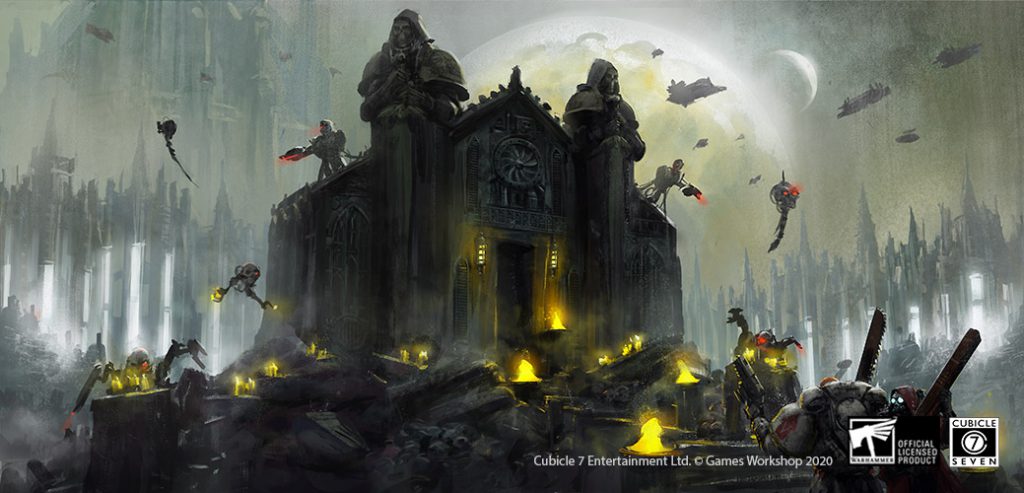
Final Thoughts
For some time now I’ve held that a good review of anything judges its subject not by comparison but rather by how well it achieves what it’s set out to do. You don’t judge a Pizza Hut by comparing it to Lucali or Grimaldi’s, and you don’t judge an RPG by comparing it to other RPGs. With a long line of Fantasy Flight RPGs preceding it, Wrath & Glory inevitably draws comparison to its predecessors but that’s not truly fair. Those games were all trying to do some very specific things, and the more universal approach taken by Wrath & Glory isn’t going to provide that same experience.
There’s one final aspect that I haven’t really covered yet, and that’s the notion of a mixed-Species party in a setting where “shoot the alien on sight” might be considered a fairly progressive policy. It can be a little shocking for some to encounter this level of xenophobia especially when they’re used to their character being accepted within the party. I can’t stress enough: if you plan to have a mixed-Species party, make sure that everyone is on board with what that means in this setting, and make sure that you’ve gone over your safety tools thoroughly.
With that in mind, my verdict on Wrath & Glory is that it’s a good game, with a few asterisks. It achieves exactly what it attempts: allowing a wide-range RPG experience within the 40k setting. As I mentioned before, it skews fairly heavily toward the human/Imperial, but that’s understandable as it’s the part of the setting that’s most relatable and also the most detailed. There are also the noted balance issues, but that’s something another pass of errata or reasonable table discussion could easily clear up. There are a lot of moving parts in Wrath & Glory as well, so while I don’t recommend this as anyone’s introduction to RPGs, that doesn’t seem to be an exceptionally likely situation and there’s nothing here an experienced GM wouldn’t be able to handle.
